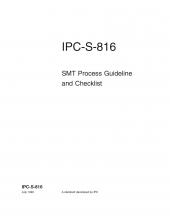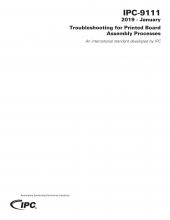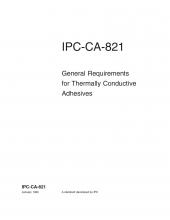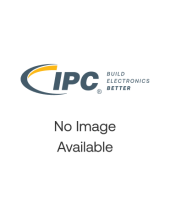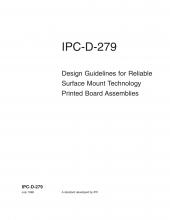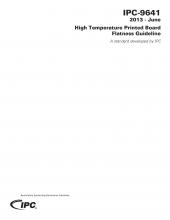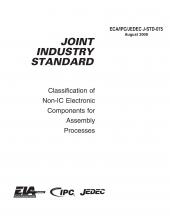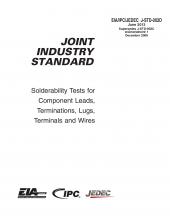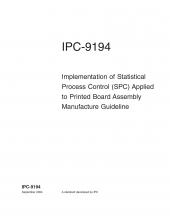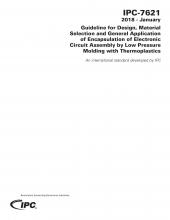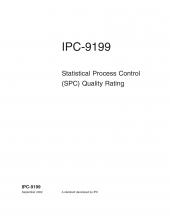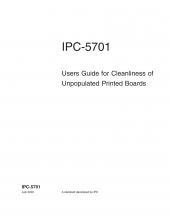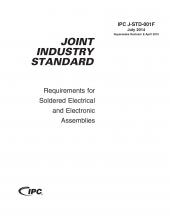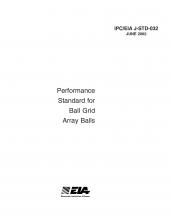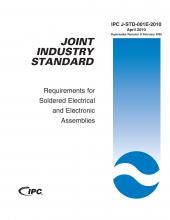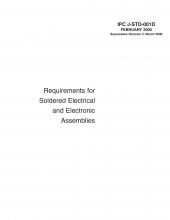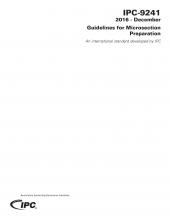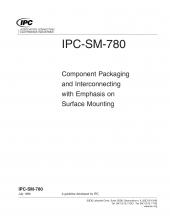Products
Why waste time looking for answers? This handy, easy-to-use troubleshooting guide lists all types of processing problems and solutions for surface mount assembly. Covers bridging, skips, misalignment, placement and more. 38 pages. Released July 1993.
The IPC-9111 handbook is a valuable resource for anyone involved in manufacturing or purchasing printed board assemblies. Issues in the assembly process are presented along with possible causes and actions to take to resolve them. Photos are provided throughout the document to assist the reader. IPC-9111 supersedes the printed board assembly sections of IPC-PE-740A.
Covers requirements and test methods for thermally conductive dielectric adhesives used to bond components in place. Permanent, removable and self-shimming adhesives are addressed. 18 pages. Released January 1995.
This document addresses the implementation of optical and optoelectronic packaging technologies. The areas discussed include: technology choices, design considerations, material properties, component mounting and interconnecting structures, assembly processes, testing, application, rework, and reliability of completed optoelectronic products. Optoelectronic packaging technologies include active...
Establishes design concepts, guidelines and procedures for reliable printed wiring assemblies. Focuses on SMT or mixed technology PWAs, specifically addressing the interconnect structure and the solder joint itself. Discusses substrates, components, attachment materials, coatings and assembly processes and testing considerations. In addition, this document contains detailed appendices covering...
This voluntary standard establishes minimum requirements for the design, installation, operation and maintenance of electrically heated process equipment in order to minimize electrical hazards and prevent fires that may occur in combustible tanks, tank liners and drying equipment.
Printed board flatness is largely affected by a change in intrinsic properties through exposure to variances in temperature. The worst case deviation of the printed board from flatness may be at room temperature, peak temperature during reflow, or at any temperature in between. Printed board flatness must therefore be characterized during the entire reflow thermal cycle, and not solely at room...
J-STD-075 picks up where J-STD-020 left off by providing test methods to classify worst-case thermal process limitations for electronic components. Classification is referenced to common industry wave and reflow solder profiles including lead-free processing. The classifications represent maximum process sensitivity levels and do not establish rework conditions or recommended processes for an...
The European Union’s Restriction of Hazardous Substances (RoHS) legislation has had a profound impact on the electronics industry. One of the restricted substances, lead (Pb), is commonly used in alloys with tin for component finishes, printed board finishes and solders. Pb-free materials directly affect product performance, reliability and service life in many ways. There have been numerous...
This standard prescribes test methods, defect definitions, acceptance criteria, and illustrations for assessing the solderability of electronic component leads, terminations, solid wires, stranded wires, lugs and tabs. A test method for the resistance to dissolution/dewetting of metallization is also included in the standard. Intended for use by both vendors and users, J-STD-002D was developed by...
This guideline standard is intended to aid in interpretation of the requirements in IPC-9191, "General Guidelines for Implementation of Statistical process Control," specifically for printed board assembly (PBA) manufacture. This document and IPC-9191 should be used together; the standards are cross-referenced to each other in the Appendices of this guideline. This standard promotes process...
Encapsulation, for the purpose of IPC-7621 standard, is defined as a low pressure molded thermoplastic, e.g., polyamide, which is brought to a liquid state and injection molded and (rather quickly) returned to a temperature below its melting point., forming a durable yet pliable (rubbery-like) form. The desired performance characteristics of low pressure molding (LPM) encapsulation depend on the...
This standard identifies the moisture sensitivity classification level of passive surface mount devices and through-hole components, subjected to reflow soldering, so that they can be properly packaged, stored, and handled to avoid subsequent thermal/mechanical damage during assembly solder reflow attachment and/or repair operation. This standard may be used to determine what classification level...
This document standardizes the performance parameters for air moving devices. The phrase "air moving device" (or "air mover") refers to equipment such as, fans, blowers and other forced air movement technologies. These air moving devices are used in the electronics industry for the cooling of heat-producing components, and range from small devices mounted directly to hot components such as...
This document is a tool for a customer or supplier organization's internal audit group to assess a statistical process control (SPC) system against the requirements of IPC-9191. This document should be used by customers and suppliers of any size and for any commodity. This tool can be used to perform an assessment of the use of SPC at both organizational and process levels. The questions in this...
Tackling PCB cleanliness is a tough job; residues on printed circuit boards are directly related to the reliability of the produced hardware and can result in serious failures if not known or monitored. But how do you measure "cleanliness"? How clean is "clean"? The IPC-5701 provides guidance into how these issues should be approached and specified in purchasing documents, addressing levels of...
IPC J-STD-001F is recognized worldwide as the sole industry-consensus standard covering soldering materials and processes. This revision includes support for both traditional solder alloys and for lead-free manufacturing. Examples of some of the significant changes are revision to plated-through hole, PTH, minimum fill requirements; criteria for two new SMT termination types; and expanded...
This standard, developed jointly by IPC and the Electronic Industries Association (EIA) establishes the construction detail requirements for balls and other terminal structures on Ball Grid Array (BGA) packages. It also establishes a set of designations and expectations for product performance. A large variety of terminal structures are recognized for a wide range of applications ranging from...
J-STD-001E is recognized worldwide as the sole industry-consensus standard covering soldering materials and processes. This revision includes support for lead free manufacturing, in addition to easier to understand criteria for materials, methods and verification for producing quality soldered interconnections and assemblies. The requirements for all three classes of construction are included...
Download the free Amendment 1 (.pdf) that resolves conflict in measles criteria between J-STD-001D, IPC-A-610D, IPC-6012B and IPC-A-600G. Lead free acceptance criteria and pictures now included! Reformatted-easier to find acceptance criteria! Space Applications Electronic Hardware Addendum Published November 2006, with Amendment 1 Published September 2009. Download the Addendum. J-STD-001D is...
Originally developed for J-STD-001B, it is also applicable to current assembly standards. Electronics manufacturers are faced with the difficult task of proving that a candidate manufacturing process can produce acceptable hardware, either to the customer of the product, or for internal quality control. Users have to determine many of the process qualification steps on their own. This document...
This standard is intended as a guideline in the proper preparation of a metallographic sample (microsection) of a printed board. The finished microsection is used for evaluating the quality of the laminate system and plated structures (e.g. PTHs and vias). Microsection sample preparation is regarded by many as a highly developed skill. The guidelines in this standard discuss the many variables and...
IPC-A-610 is the most widely used electronics assembly standard in the world. A must for all quality assurance and assembly departments, IPC-A-610E illustrates industry-accepted workmanship criteria for electronics assemblies through full-color photographs and illustrations. Topics include flex attachment, board in board, part on part, lead free, component orientation and soldering criteria for...
Provides information on multichip module technology, including parametric data, design and manufacturing information and a proposed categorization of various approaches to multichip interconnect substrate technologies based on dielectric family. 120 pages. Released August 1992.
This document examines key issues in advanced packaging techniques. Provides information on what types of parts are available, the techniques and processes necessary for their proper use, possible advantages/disadvantages or problems, how to start implementation and where to find additional information. 138 pages. Released March 1988.
Coming Soon
IPC-7095E: Design and Assembly Process Implementation for Ball Grid Arrays (BGAs)
IPC-7530B: Guidelines for Temperature Profiling for Mass Soldering Processes (Reflow & Wave)
IPC-2294: Design Standard for Printed Electronics on Rigid Substrates
IPC-6904: Qualification and Performance Specifications for Printed Electronics on Rigid Substrates
IPC-4105: Specification for Metal Base Copper Clad laminates for Rigid Printed Boards

